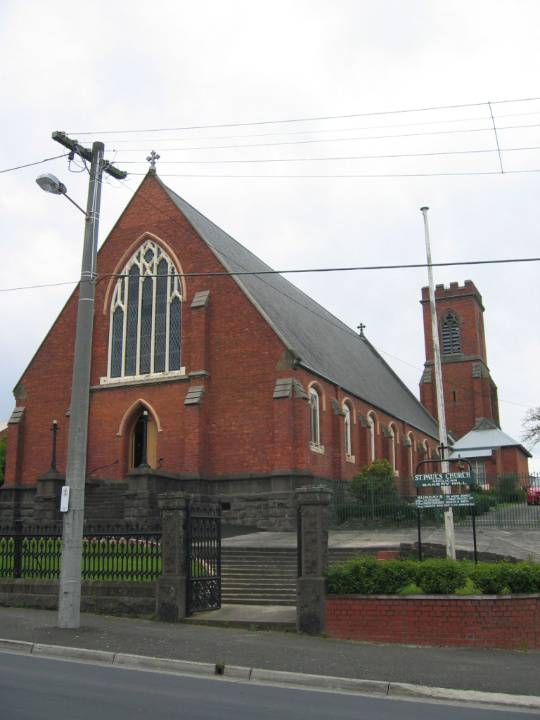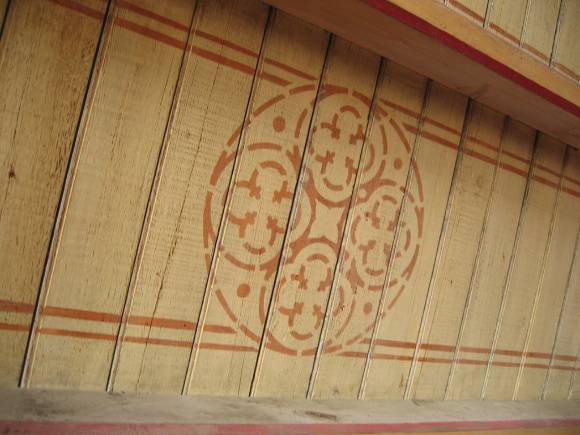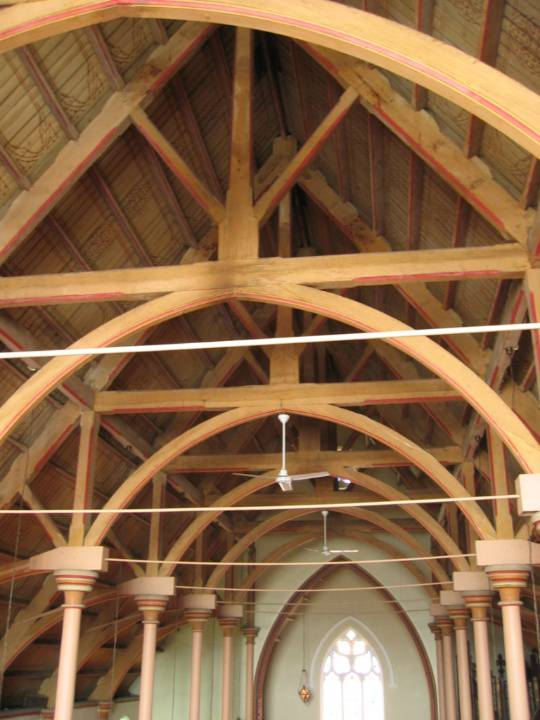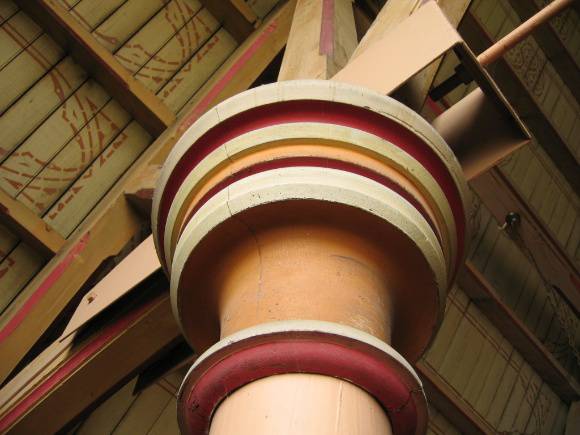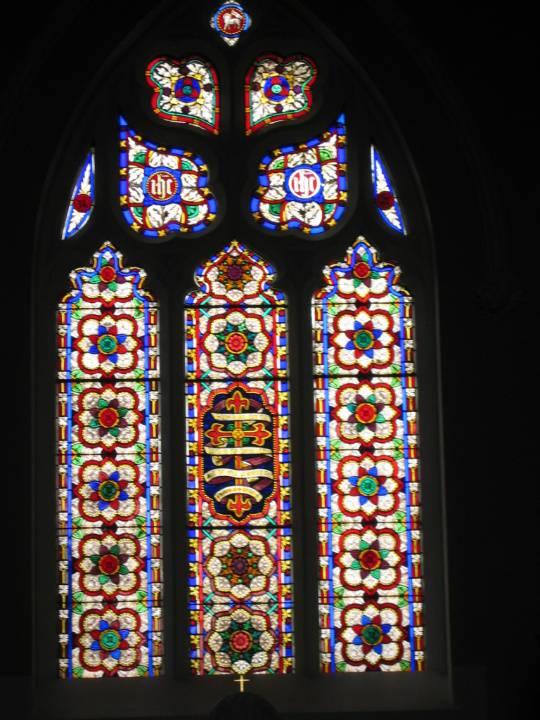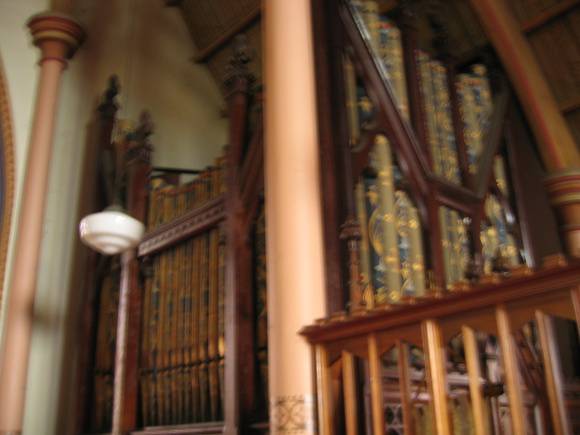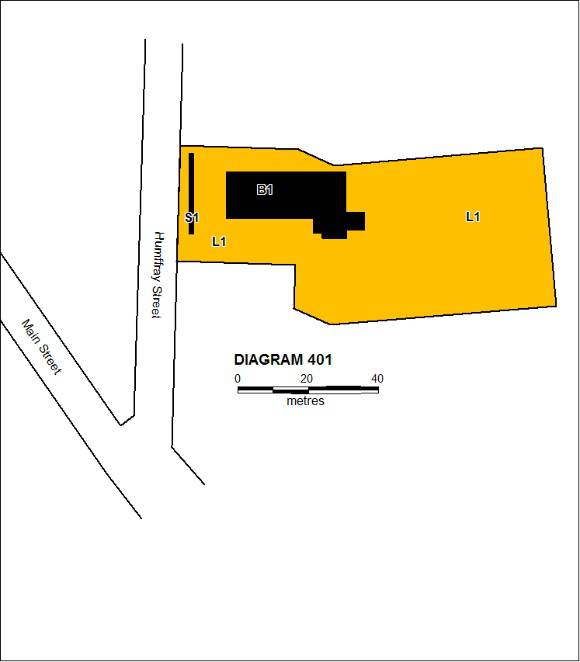| Back to search results » | Back to search page » |
|
ST PAULS ANGLICAN CHURCH
Other NamesST PAUL'S , ST PAUL'S BAKERY HILL , ST PAULS' CHURCH Location3 HUMFFRAY STREET SOUTH BAKERY HILL, BALLARAT CITY
File Number12/001129-01LevelRegistered |
|
Statement of Significance
What is significant? St Paul's Anglican Church is located on Bakery Hill. The church is a red brick Victorian Transitional Decorated and Perpendicular Gothic Revival church constructed in 1864 to a design by Victorian architect Leonard Terry (1825-1884). It incorporates a number of elements from an earlier church on the site, constructed in 1861. These include the large square castellated tower, the Ferguson and Urie triple chancel window and internal timber members. The church comprises a gabled nave and rear gabled chancel and porch, a timber mezzanine gallery, the tower at the rear and a vestry, added in 1892. The extant wrought iron fence with ornate gates and pillars at each end were constructed in 1869. More recent alterations to the church include replacement of the large west window at the front of the church in the 1950s and construction of a new Rectory on south side of the church in 1963. At the rear of the church is a small timber Verger's Cottage, known to have existed on its present site since 1902. The congregation of St Paul's was formed at Bakery Hill in 1854, three years after the discovery of gold in Ballarat. Following an earlier temporary tent structure, the first brick church was constructed on the site in 1858 when the Parish of St Paul's was established. In 1864 the first church collapsed when the ground of Bakery Hill, weakened by mining tunnels, subsided after rain. The extant brick church was erected on more stable ground west of the earlier church, with the surviving tower incorporated at the rear. Terry incorporated an ingenious subfloor system at the grid lines of the salvaged columns to enable variation and rectification to support the building, were there to be any further mining subsidence. Tall, round, slender timber columns of the nave support central king post trusses with full width brackets between posts and shallow brackets over the side aisles. The timber columns appear to be reused from the earlier 1861 church along with the Ferguson and Urie windows, the pews in the mezzanine gallery, and bricks salvaged from the collapsed structure. Some original painted stencilling from 1864 survives, albeit in reduced extent, on the chancel arch, timber lining board ceiling of the nave and some timber columns. The church organ built in 1864 by J. W. Walker of London for the original church was then incorporated into the new church. It was enlarged by Fincham and Hobday in 1892 and rebuilt by Fincham and Sons in 1957. It retains its original case, pipe work and tonal scheme. The site of St Paul's is on Bakery Hill. Mass meetings at Bakery Hill were held in 1854 where disgruntled miners assembled to voice complaints about mining licenses in the weeks leading up to the Eureka Stockade. Bakery Hill is a large area and the site of St Paul's is not specifically documented as a rallying point for these meetings. However the congregation was active at this site at this time. The ground to the east of the church tower where the 1858 church was located is one of the few parts of Bakery Hill remaining as open space and may have archaeological potential. The site of St Paul's is the site of the earliest Anglican church services in Ballarat and is associated with the ongoing role of the church in the Ballarat community. The church is of interest for its association with Anglicanism in Ballarat, How is it significant? St Paul's Anglican Church is of historical, architectural and aesthetic significance to the State of Victoria. Why is it significant? St Paul's Church is historically significant for its association with the early Ballarat goldfields and deep lead mining at Bakery Hill, the form of the existing church, replacing the earlier 1861 church, having been influenced by the presence of the deep lead below the site. The juxtaposition of nave and tower enables interpretation of the history of the site in that the tower of the collapsed 1861 church was incorporated into a new building to the west. The rare sub-floor structure may have been a response to the unstable nature of the site. St Paul's Church is architecturally significant as an unusual example of a masonry building with an internal timber post and truss system, for its rare heavy timber subfloor structure intended to transfer load away from unstable areas, and for the surviving stencil decoration. St Paul's Ballarat is of aesthetic significance for the east chancel window by Ferguson and Urie (1862) installed in the first church and reused in the extant church. The window is an early example of their work, in grisaille pattern, likely to have been assembled in Australia from imported glass. The window is signed 'Ferguson and Urie' but possibly created by John Lyon who commenced work with the company in 1861.
Group
Religion
Category
Church


